 W
WThe alley-oop is an American football play in which the quarterback throws the ball high into the air, and another player jumps up and catches it. The play was developed in 1957 by San Francisco 49ers players Y. A. Tittle and R. C. Owens. The play was named after V. T. Hamlin's comic strip character Alley Oop; Owens himself was also known as "Alley Oop". It was highly successful when utilized due to Owens' 6 ft 3 in height and ability to out-leap defenders.
 W
WIn American football, a bootleg play is a play in which the quarterback runs with the ball in the direction of either sideline behind the line of scrimmage. This can be accompanied by a play action, or fake hand off of the ball to a running back running the opposite direction.
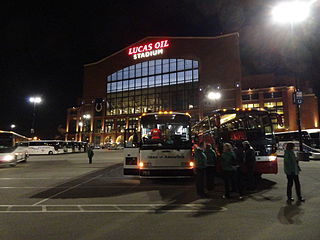 W
WThe Colts Catastrophe was an ill-fated trick play attempted by the National Football League (NFL)'s Indianapolis Colts on October 18, 2015. The fake punt, attempted in a regular-season game against the New England Patriots, failed in spectacular fashion, and resulted in a tackle for loss, penalty, and harsh criticism of the players and coaches involved.
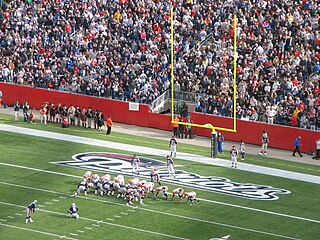 W
WThe conversion, try, or convert occurs immediately after a touchdown during which the scoring team is allowed to attempt to score one extra point by kicking the ball through the uprights in the manner of a field goal, or two points by bringing the ball into the end zone in the manner of a touchdown.
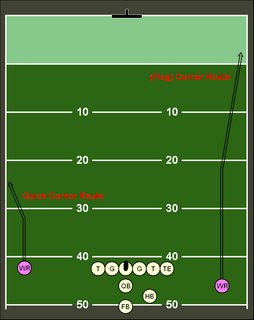 W
WA corner route is a pattern run by a receiver in American football, where the receiver runs up the field and then turns at approximately a 45-degree angle, heading away from the quarterback towards the sideline. Usually, the pass is used when the defensive back is playing towards the inside shoulder of the receiver, thus creating a one on one vertical matchup. The corner route is less likely to be intercepted when compared to the slant route, because it is thrown away from the middle of the field. The pass is used frequently in the West Coast offensive scheme, where quick, accurate throwing is key. The pass may also be used closer to the goal line in what is called a "fade". The quarterback will lob the ball over a beaten defender to a wide receiver at the back corner of the end zone.
 W
WA curl route, also called a hitch or hook, is a pattern run by a receiver in American football, where the receiver appears to be running a fly pattern but after a set number of steps or yards will quickly stop and turn around, looking for a pass. This generally works best when the defending corner or safety commits himself to guarding the fly and is unable to stop quickly enough to defend the pass. A "curl out" on the sideline is often referred to as a comeback route.
 W
WA "dive" is a type of play in American football in which the ball carrier attempts to thrust quickly over the line of scrimmage, rushing through the linemen. A dive or buck is distinct from both an end run and an off-tackle run; the gap for the runner can be either between center and guard or between guard and tackle.
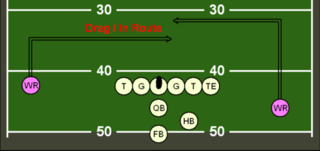 W
WA drag route is a route run by a receiver in American football, where the receiver runs a few yards downfield, then turns 90° towards the center of the field and runs parallel to the line of scrimmage. This type of route is relatively safe, and often leads to a receiver making a play after the catch. Alternatively, a drag route may be used as a second option if the principal receiver on a play is covered.
 W
WIn gridiron football, an end run is a running play in which the player carrying the ball tries to avoid being tackled by running outside the end of the offensive line. It is distinct from a dive, which is a run "up the middle", or an off-tackle run, which is a run through the inside gap created by the offensive tackle. Most option offenses are based on the end run.
 W
WThe end-around is a play in American football in which an end or wide receiver crosses the backfield towards the opposite end of the line and receives a handoff directly from the quarterback. The receiver then may proceed to do one of two things: he either runs the ball towards the line of scrimmage in order to gain yardage, or more rarely, attempts to pass to another eligible pass receiver. Both versions of the end-around are uncommon and can be considered trick plays. The play can also be combined with a Statue of Liberty play.
 W
WA fake punt is a trick play in American football. Simply, it involves a running or passing play run out of a punt formation. It can take a number of different forms. Usually the punter will simply take the snap and look to throw a pass or run with the ball after the defenders have turned downfield to block for the punt return. In another variation, the ball may be snapped directly to one of the backs who then runs downfield or throws.
 W
WA field goal (FG) is a means of scoring in gridiron football. To score a field goal, the team in possession of the ball must place kick, or drop kick, the ball through the goal, i.e., between the uprights and over the crossbar. American football requires that a field goal must only come during a play from scrimmage, while Canadian football retains open field kicks and thus field goals may be scored at any time from anywhere on the field and by any player. The vast majority of field goals, in both codes, are place kicked. Drop kicked field goals were common in the early days of gridiron football but are almost never done in modern times. In most leagues, a successful field goal awards three points.
 W
WA flat route is an American football route, used in passing plays. A flat route is usually run by a running back or a fullback. When run by a receiver it can be known as a speed out or arrow route. The eligible receiver runs parallel to the line of scrimmage till near the sidelines and turns toward the quarterback to wait for the pass. The QB's pass should arrive when he is not yet past the line of scrimmage. The receiver will then turn upfield at the sideline and run straight down the field.
 W
WA flea flicker is an unorthodox play, often called a "trick play", in American football which is designed to fool the defensive team into thinking that a play is a run instead of a pass. It can be considered an extreme variant of the play action pass and an extension of the halfback option play.
 W
WA fly route, also called a straight route, vertical route, streak route or go route, is a pattern run by a receiver in American football, where the receiver runs straight upfield towards the endzone. The goal of the pattern is to outrun any defensive backs and get behind them, catching an undefended pass while running untouched for a touchdown. Generally, the fastest receiver on the team or any receiver faster than the man covering him would be the one to run these routes. When run down the sidelines, a fly can be called a fade route.
 W
WIn several forms of football a forward pass is a throwing of the ball in the direction that the offensive team is trying to move, towards the defensive team's goal line. The forward pass is one of the main distinguishers between gridiron football in which the play is legal and widespread, and rugby football from which the North American games evolved, in which the play is illegal.
 W
WA Hail Mary pass is a very long forward pass in American football, typically made in desperation, with great diffculty of achieving a completion. Due to the small chance of success, it makes reference to the Catholic Hail Mary prayer for help.
 W
WThe horse-collar tackle is an American football maneuver in which a defender tackles another player by grabbing the back collar or the back-inside of an opponent's shoulder pads and pulling the ball carrier directly downward violently in order to pull his feet from underneath him. The technique is most closely associated with Pro Bowl safety Roy Williams.
 W
WThe jump shift or Heisman shift, was an American football shift maneuver utilized by John Heisman. In this system, only the center was on the line of scrimmage, and the backfield would be in a line, as one would in an I-formation with an extra halfback at the hind end, or a giant T. The players could shift into various formations. In one version, the line shifted so that the center was between guard and tackle, and the three back nearest the line of scrimmage would shift all to one side. A split second elapsed, then the ball was snapped and the wall of three blockers charged on. If needed, the center could also snap it to one of the other backs. The phalanx of blockers resembled the yet-to-be developed single wing. The Heisman shift was considered more complicated than its predecessors.
 W
WA kickoff is a method of starting a drive in gridiron football. Typically, a kickoff consists of one team – the "kicking team" – kicking the ball to the opposing team – the "receiving team". The receiving team is then entitled to return the ball, i.e., attempt to advance it towards the kicking team's end zone, until the player with the ball is tackled by the kicking team, goes out of bounds, or scores a touchdown. Kickoffs take place at the start of each half of play, the beginning of overtime in some overtime formats, and after scoring plays.
 W
WIn gridiron football, a lateral pass or lateral occurs when the ball carrier throws the football to a teammate in a direction parallel to or away from the opponents' goal line. A lateral pass is distinguished from a forward pass, in which the ball is thrown forward, towards the opposition's end zone. In a lateral pass the ball is not advanced, but unlike a forward pass a lateral may be attempted from anywhere on the field by any player to any player at any time.
 W
WThe Minnesota shift is an old American football offensive maneuver that was a forerunner of other shifts and pre-snap formation changes in the game. It consists of a sudden switch into a new offensive formation immediately before the ball is snapped with the intent of keeping the defense off balance and disguising the intended point of attack. University of Minnesota Golden Gophers coach Dr. Henry L. Williams is credited with its invention in the first decade of the 20th century, and his institution lends its name to the shift.
 W
WAn off-tackle run in American football is a play in which the running back carries the ball through a running lane off of the tackle's block. The lead block kicks out the end man on the line of scrimmage, and another offensive player usually blocks the linebacker. It can be useful in short yardage situations, and with large backs.
 W
WIn gridiron football, an onside kick is a kickoff deliberately kicked short in an attempt by the kicking team to regain possession of the ball. This is in contrast with a typical kickoff, in which the kicking team intends to give the ball to the other team and thus kicks the ball far downfield in order to maximize the distance the receiving team has to advance the ball in order to score. The risk to the team attempting an onside kick is that if it is unsuccessful and the receiving team gets the ball, the receiving team usually has a much better field position than it might have with a normal kickoff. Rules and procedures for onside kicks differ between the different codes and leagues of gridiron football.
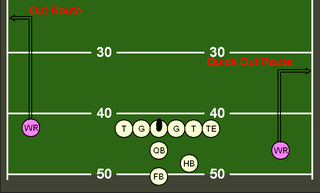 W
WAn out route is a pattern run by a receiver in American football. On an out route, the receiver will start running a fly pattern but, after a certain number of steps, will cut hard 90 degrees "to the outside", or toward the sideline, away from the quarterback. If the cut comes very quickly, usually after only a few steps, it is called a "quick out". Out routes generally allow a one-on-one match-up between the receiver and the defensive back who is guarding him, as safeties generally are concerned with helping out on long routes downfield or the center of the field.
 W
WThe place kick is a type of kicking play commonly used in American football, association football (soccer), Canadian football, rugby league, and rugby union.
 W
WA play-action pass is an American football play. The play action starts with what appears to be a running play, but turns out to be a pass play; in this way, it can be considered the opposite of a draw play. Play-action passes are often used against defenses that are focused on stopping the run. By initially simulating a running play, the offense attempts to deceive the defense into acting on the fake run and being out of position in their pass coverage, giving receivers more time and room to be free to receive passes behind the linebackers.
 W
WA post is a moderate to deep passing route in American football in which a receiver runs 10–20 yards from the line of scrimmage straight down the field, then cuts toward the middle of the field at a 45-degree angle.
 W
WIn gridiron football, a punt is a kick performed by dropping the ball from the hands and then kicking the ball before it hits the ground. The most common use of this tactic is to punt the ball downfield to the opposing team, usually on the final down, with the hope of giving the receiving team a field position that is more advantageous to the kicking team when possession changes. The result of a typical punt, barring any penalties or extraordinary circumstances, is a first down for the receiving team. A punt is not to be confused with a drop kick, a kick after the ball hits the ground, now rare in both American and Canadian football.
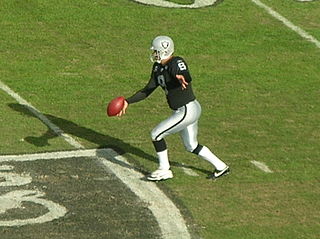 W
WA punter (P) in gridiron football is a special teams player who receives the snapped ball directly from the line of scrimmage and then punts (kicks) the football to the opposing team so as to limit any field position advantage. This generally happens on a fourth down in American football and a third down in Canadian football. Punters may also occasionally take part in fake punts in those same situations, when they throw or run the football instead of punting.
 W
WThe Pyramid Play is a defensive play in American football, where a defensive player is hoisted up by two other players in an effort to block a place kick attempt by the opposing team. The play was created and implemented by the 1933 Oregon State Agricultural College team.
 W
WA quarterback keeper or keeper in American football is a designed play in which the quarterback does not pass or hand off the ball to another player and instead rushes forward with it in an effort to gain yardage. The play typically is run in instances where only a few yards are needed to gain a first down or touchdown, due to the threat of injury to the quarterback and most quarterbacks' ineffectiveness at running the ball when compared with a running back or fullback; however, this play is called more often with dual-threat quarterbacks. Variations include a quarterback sneak, quarterback sweep or quarterback "power".
 W
WA quarterback scramble or scramble is an impromptu maneuver or run in gridiron football by a quarterback. If a quarterback is under pressure by an opposing team's defense, he may run forward, backward, or laterally in an attempt to avoid being tackled behind the line of scrimmage—a quarterback sack. A scramble is not usually a designed play, but instead is the action of a quarterback to avoid being sacked by the defense or an improvised run forward to gain yardage if an opportunity presents itself.
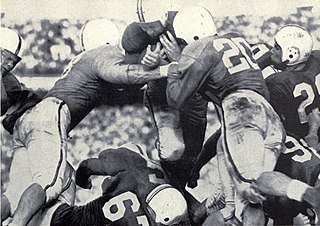 W
WA quarterback sneak is a play in gridiron football in which the quarterback, upon taking the center snap, dives ahead while the offensive line surges forward. It is usually only used in very short yardage situations.
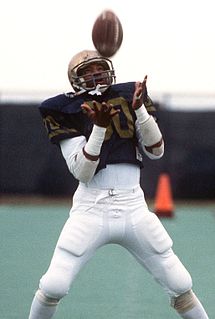 W
WIn gridiron football, a reception, also known informally as a catch, is part of a passing play in which a player in bounds successfully catches (receives) a forward pass thrown from a friendly quarterback behind the line of scrimmage. After making the catch, the receiver will then proceed to run towards the opposing end zone carrying the ball and try to score a touchdown, unless the play ends due to him being downed or forced out of bounds. Yardage gained from the passing play are credited to the catcher as his receiving yards.
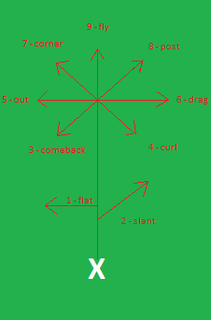 W
WA route is a pattern or path that a receiver in gridiron football runs to get open for a forward pass. Routes are usually run by wide receivers, running backs and tight ends, but other positions can act as a receiver given the play.
 W
WRushing is an action taken by the offense that means to advance the ball by running with it, as opposed to passing, or kicking.
 W
WA slant route is a pattern run by a receiver in American football, where the receiver runs up the field at approximately a 45-degree angle, heading to the gap between the linebackers and the linemen. Usually, the pass is used when the corner or nickelback are playing farther away from the receiver, so a quick pass is able to be completed before the defender has time to try to break up the pass. The pass is used frequently by "Slant Boy" Michael Thomas of the New Orleans Saints in the West Coast system where quick, accurate throwing is key. This route is most commonly used to exploit the cover 2 defense. Usually throwing in the seam between the safety and the cornerback is the key to getting a completion using this route. Coined by Rowan J Griperay, the record setting receiver.
 W
WA sweep is a running play in American football where a running back takes a pitch or handoff from the quarterback and starts running parallel to the line of scrimmage, allowing for the offensive linemen and fullback to get in front of him to block defenders before he turns upfield. The play is run farther outside than an off tackle play. Variants of the sweep involve the quarterback or a wide receiver running with the ball, rather than a running back.
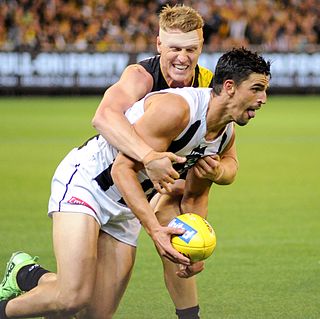 W
WMost forms of football have a move known as a tackle. The primary and important purposes of tackling are to dispossess an opponent of the ball, to stop the player from gaining ground towards goal or to stop them from carrying out what they intend.
 W
WIn football, the tackle-eligible play is a forward-pass play in which coaches will attempt to create mismatches against a defense by inserting an offensive tackle, into an offensive formation as an eligible receiver, usually as a tight end or as a fullback. This is done by changing the formation of the offensive line, via positioning two linemen on one side of the center and three linemen on the other.
 W
WA wheel route is a pattern run by a receiver or running back in American football. If a receiver runs it, they will immediately run a quick out pattern, then proceed to turn upfield in a curved pattern. Typically this route is run by an inside receiver, with the number one receiver heading inside to exploit coverage in the defense. When run from the running back position the player will run towards the sideline while looking back at the quarterback as if about to receive a pass on a flare route. The running back will then turn upfield at the sideline and run straight down the field.